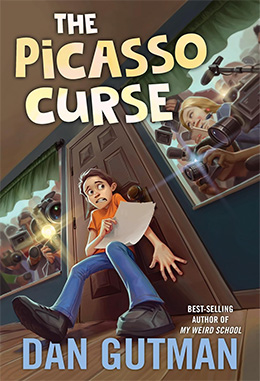Avi’s 2025 Summer Blog Series
Dan Gutman
From Avi: As I have for the last three summers, (summer of 2024, summer of 2023, summer of 2022) I’ve invited 13 admired authors to write for my blog for the next three months. I hope you’ll tune in each Tuesday to see who answered this year’s question, which we hope provides you with inspiration. And by the end of the summer, you’ll have new authors to follow!
What’s your favorite strategy for encouraging young people to read?

I tell them this — If you read something you’re interested in, you’ll get interested in reading.
When I was a kid, I hated to read. I thought it was boring and hard to do. Then, when I was about ten, I became a baseball fan. Suddenly I wanted to know everything about baseball, so I had to read about it. So I tell kids there’s something out there that you’re interested in. Maybe it’s sports, or cars, or airplanes, or whatever. There are books on that subject. Lots of them. You should check them out.
Because I was a reluctant reader myself, I relate to those kids and I know what they like to read and what they don’t like to read. I boil it down to seven secrets to writing stories that kids will want to read …
- GET TO THE POINT. Hook the reader on the first page. Better yet, on the first sentence.
- NO PADDING. Delete extra words. They only confuse readers. If there’s a paragraph, sentence, scene, or character that isn’t important to the story, get rid of it.
- USE THE BARE MINIMUM OF DESCRIPTION. Cut unnecessary adjectives. Don’t tell readers what the weather is like, what kind of clothes people wear, or what their face looks like. Who cares? It doesn’t matter. Let the reader use his or her imagination.
- EACH CHAPTER SHOULD BE A STANDALONE STORY with a beginning, a middle, and an end. And the ending of each chapter should make the reader want to know what happens next.
- MAKE IT FLOW. The text should flow effortlessly from one word to the next, one sentence into the next, one paragraph to the next, and so on. The reader should never have to read something twice to understand what I’m saying.
- TAKE READERS ON A ROLLER COASTER RIDE. Give them something exciting, then calm them down a little. Then give them something else that’s exciting. Keep doing that. People crave novelty. If a roller coaster didn’t go up and down, it would be just a boring train ride.
- GIVE THEM A SURPRISE ENDING. It doesn’t have to be happy. It just has to be satisfying in some way and provide closure.
At the end of a roller coaster, it takes you back to where you started. I think people like stories that come full circle. There’s something satisfying when you get taken on a journey and then back home on the last page. It’s like baseball. The batter’s goal is to make it all the way around the bases until he ends up back where he started—scoring a run at home plate.
To sum up, I try to write stories that I would like to read myself, and I figure kids will want to read stories like that too.
Also, I have the brain of an eight-year-old, so that helps.
Particulars
New York Times best-selling and award-winning author Dan Gutman has written more than 190 books for readers from kindergarten through middle school. Dan’s My Weird School series includes 100+ titles, and has sold more than 35 million copies globally over the past 20 years. Dan also is the author of the best-selling Genius Files series, the Baseball Card Adventure series, and many more. When he’s not writing books, Dan loves to ride his bike, play pickleball, throw Frisbees, and explore New York City where he lives with his wife Nina.


1 thought on “2025 Summer Blog Series: Dan Gutman”
Excellent advice from Dan Gutman. One of the best children’s author today.